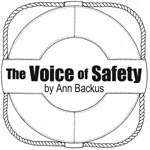Suppose a Munition Appears in
Your Dredge
Ann Backus, MS

Is it reasonable to assume that one day while dredging as usual off the East Coast you could land munitions with your catch? What would that mean? What might be the risks to crew and catch? What would you do?
How far fetched is this idea? Well, not horribly far fetched as it happened a few years to at least one boat that unloaded in New Bedford, MA. Recently, in January 2017, multiple agencies met in New Jersey to discuss what action fishermen should take if they encounter munitions.
As interesting as a munition casing might be, it is not a collector’s item. Meaning that rather than dumping this catch out on the deck, the first move is action to notify the US Coast Guard. The second would be to proceed as directed and to record the latitude and longitude and perhaps depth where it was snagged.
What’s up with this situation?
Apparently World War I munitions were dumped off the coast of New Jersey and are sitting on the ocean floor in multiple locations that have been mapped, but may be lurking in many other locations along the East Coast.
These munitions are unexploded casings that may contain nerve or mustard gas.
The case: Sunday June 6, 2010, E.S.S. Pursuit landed two munitions in a dredge of surf clams. One of the crew members was exposed to a substance which leaked from one of the torpedo-shaped casings. When the Pursuit landed at New Bedford on Monday, June 7, it off-loaded the catch and one 28 year old fisherman was sent to St. Luke’s hospital in New Bedford with serious blistering on his right foreman and left leg plus shortness of breath and redness on his skin. Later a second fisherman was treated at St. Luke’s for shortness of breath and itchy, red skin. The first fisherman was transferred to UMASS Medical Center in Boston and samples, collected from both men, were sent to the Level 1 Laboratory in Boston.
The laboratory response included staff from the Massachusetts Departments of Public Health, Environmental Health, from the Centers for Disease Control, as well as the Coordinator of the FBI Weapons of Mass Destruction. By 7:00 pm the tests for both fishermen had been completed and showed exposure to sulfur mustard, also known as mustard gas.
These ailing fishermen were treated and the first one eventually received several skin graphs to repair the blistered skin.
This is hardly the end of the story. What about the catch...the surf clams that were in the same dredge with the leaking canister? Were they contaminated? At this point in the story the clams are in a refrigerator at SeaWatch International in New Bedford and the US Coast Guard, U.S. Environmental Protection Agency and the New Bedford Fire Department have been notified and have responded. By mid afternoon, the Field Supervisor sent by the Massachusetts Department of Public Health, Food Protection Program Seafood Division, has placed an embargo on the entire catch and ordered it isolated in a refrigerated space.
Incident Command Post and Unified Command
Meanwhile on the waterfront, an Incident Command Post was sent up involving the City of New Bedford, US Coast Guard, the Environmental Protection Agency, Explosive Ordinance Disposal (EOD) staff, and others. The Pursuit was anchored off-shore to avoid contaminating the waterfront and other personnel.
On Tuesday, June 8, a Unified Command was set up with the US Coast Guard in charge and many agencies involved including the HazMat Responders.
The eventual outcome was that the Pursuit was decontaminated and the contaminated clams were repackaged, scanned for munitions and sent in 17 tractor trailers to hazardous waste incinerators in other states. The tractor trailers were decontaminated upon return to Massachusetts and checked for residual sulfur mustard. The clam cages and refrigerator unit were also decontaminated and checked for residuals.
In all, over 24,000 tons, yes tons, of clams were incinerated under the supervision of the Massachusetts Department of Public Health Food Protection Division.
What action should fishermen take?
Underwater munitions is a worldwide problem. There does not seem to be a clear protocol for fishermen who encounter these munitions. The New Jersey Department of Health is trying to find ways to inform fishermen, but admittedly do not have a definitive process for dealing with munitions that fishermen “catch.”
For now the best course of action is to:
• Check dredges as they come up for munitions
• Avoid contact with any munitions as they could explore or contain toxic gas, liquid or solid;
• Monitor crew for signs and symptoms of exposure;
• Contact the US Coast Guard on Channel 16 and follow their directions;
• Contact your state department of environmental protection;
• Contact the Food and Drug Administration (1-888-INFO-FDA or 1-888-463-6332, option#1).
• If you throw the munitions or contents of the dredge back, note the longitude and latitude and report the coordinates to the US Coast Guard so that the site can be identified and avoided by fishermen in the future.
Ann Backus, MS is an Instructor in Occupational Health at Harvard School of Public Health, 665 Huntington Ave., Boston MA 02115, 617-432-3327, abackus@hohp.harvard.edu.
